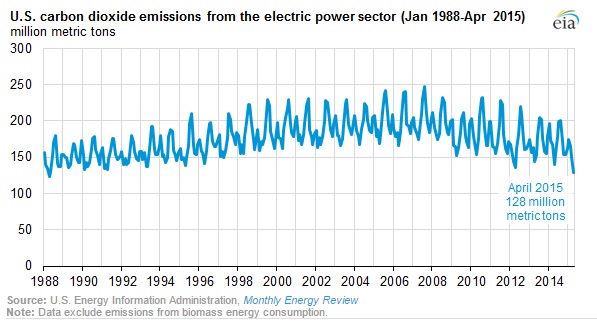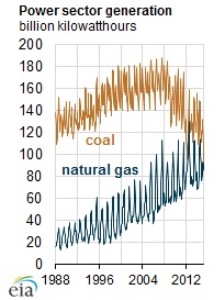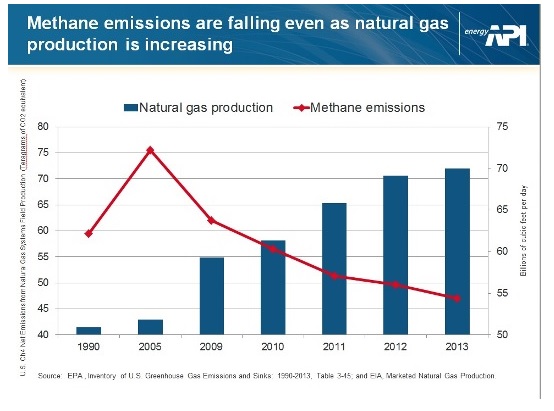New government stats on falling carbon dioxide (CO2) emissions from electrical power generation point to a good-news story on energy and climate, one that should grab the attention of policymakers nationally and in the states. Take a look at this chart from the U.S. Energy Information Administration (EIA):

The blue-green line plots CO2 emissions from the electric power sector from 1988 to this April, when those emissions hit their lowest point for any month in 27 years. This is largely because of increased use of natural gas in power generation – a market choice that’s based on the availability and affordability of natural gas, as well as the fact it is clean-burning. Among the line’s zigs and zags you can see the angle of the emissions line is down, starting around 2008 – which coincides with the onset of America’s shale energy revolution.
 This second EIA chart shows the shares of power generation from coal and natural gas intersecting in the past couple of years, reflecting the growth of clean-burning natural gas in the power generation sector.
This second EIA chart shows the shares of power generation from coal and natural gas intersecting in the past couple of years, reflecting the growth of clean-burning natural gas in the power generation sector.
Again, the big-picture story here is that the power generation from natural gas (27 percent of the U.S. total in 2013 and projected by EIA to be 31 percent in 2040) is helping achieve CO2 emissions. That’s the marketplace in action. Dan Whitten, America’s Natural Gas Alliance:
“It’s telling that in April 2015 – the month the United States generated more electricity from natural gas than from any other fuel source – the United States also emitted less carbon dioxide into the atmosphere than at any time since 1988. That’s no coincidence. … We have a high degree of confidence that natural gas will play a significant and growing role in electricity markets. It is clean, affordable and abundant – all reasons why states will plan a robust role for this American fuel when they begin making choices about what power source to use.”
Natural gas is integral to generating the electricity that enables modern living – from heating and cooling our homes to preparing our food to everyday conveniences. Together with oil, natural gas supplies about 63 percent of the energy we use today, and EIA estimates the two will supply about 62 percent in 2040. These are the energies of today and tomorrow.
It’s worth noting that in another emissions area, methane, we see a similar trend line associated with emissions from natural gas development – falling – and for similar, market-based reasons. EPA’s Greenhouse Gas Inventory Report issued this spring showed methane emissions from hydraulically fractured natural gas wells are down 79 percent since 2005 – a period in which natural gas production has soared:

Howard Feldman, API’s senior director of regulatory and scientific affairs:
“Even as oil and natural gas production has risen dramatically, methane emissions have fallen, thanks to industry leadership and investment in new technologies. Methane is the primary component of natural gas, and emissions will continue to fall as operators innovate and find new ways to capture and deliver more of it to meet consumer demands.”
Developing and using natural gas is good for America: good for our economy and our way of life. Its qualities as a fuel are reflected in the market choices made by power generators and consumers, and these choices in turn are helping the country achieve its climate goals.
By Mark Green
Originally posted August 5, 2015
Energy Tomorrow is brought to you by the American Petroleum Institute (API), which is the only national trade association that represents all aspects of America’s oil and natural gas industry. Our more than 500 corporate members, from the largest major oil company to the smallest of independents, come from all segments of the industry. They are producers, refiners, suppliers, pipeline operators and marine transporters, as well as service and supply companies that support all segments of the industry

